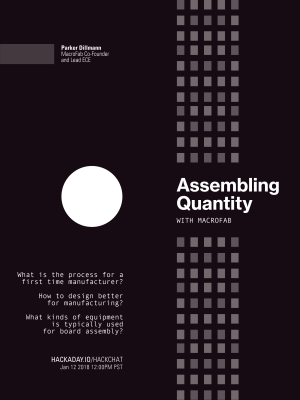Building one of something is easy. You see it here every day, and yes, building a single robot, or a board to convert Segas to HDMI, or an Internet of Things thing is easy. Manufacturing is another story entirely. You’re going to have BOMs to work with, you’ll have suppliers, and you need to deal with assembly, programming, and packaging. Do you even know where you’re going to store all those boxes of parts? Manufacturing is a difficult task, but luckily there are assembly houses and contract manufacturers ready to ease the burden a little.
 For this week’s Hack Chat, we’re going to be talking about Assembly as a Service through MacroFab. MacroFab is an online assembly house and contract manufacturer that makes creating hardware simple. If you thought sending a board file off to OSH Park and receiving a PCB in a week is amazing, you clearly haven’t experienced MacroFab. Here, you can upload your board and BOM, and with minimal effort, receive a completely populated product in a few weeks.
For this week’s Hack Chat, we’re going to be talking about Assembly as a Service through MacroFab. MacroFab is an online assembly house and contract manufacturer that makes creating hardware simple. If you thought sending a board file off to OSH Park and receiving a PCB in a week is amazing, you clearly haven’t experienced MacroFab. Here, you can upload your board and BOM, and with minimal effort, receive a completely populated product in a few weeks.
Our guest for this week’s Hack Chat will be [Parker Dillmann], MacroFab co-founder, with backgrounds in embedded design and DSP. He runs longhornengineer, a blog full of amazing projects that fit in well with the usual Hackaday fare. Shoutouts are especially deserved for the Game Boy VGA adapter.
During this week’s Hack chat, we’re going to be talking to [Parker] about manufacturing, the pitfalls, how you can better design for manufacturing (DFM), the machines used by MacroFab, pogo pin adapters, solder fountains, and all the cool stuff that turns one of a thing into thousands of a thing. If you’re wondering what MacroFab’s results look like, you’ve probably already held a few in your hands; the badge for this year’s Hackaday Superconference was manufactured by MacroFab, as were a lot of the independent badges at last year’s Def Con.
During this Hack Chat, we’ll be discussing:
- What is the process for a first-time manufacturer?
- Where can you find out how to design better for manufacturing?
- What kinds of products are made at MacroFab?
- What kinds of equipment is typically used for board assembly?
As always, we’re looking for questions from the community, you can add those as a comment on the Hack Chat event page.
Our Hack Chats are live community events on the Hackaday.io Hack Chat group messaging. This Hack Chat is going down Friday, January 12th at noon, Pacific time. Time Zones got you down? Here’s a handy countdown timer!
Click that speech bubble to the left, and you’ll be taken directly to the Hack Chat group on Hackaday.io.
You don’t have to wait until Friday; join whenever you want and you can see what the community is talking about.

















>You see it here every day, and yes, building a single robot, or a board to convert Segas to HDMI, or an Internet of Things thing is easy.
Oh, come on…those things may not be very complicated after you spend weeks digging into the details of the application and trying a few things that don’t work and breaking at least one expensive part, but they aren’t EASY.
I find myself doing this all the time, you think of how you could make something and don’t see any problems – maybe you’ve even done each individual step before on its own – but in reality, it always takes ten times the time and effort you envision to get anything which works reliably. Making and automating things easier than it ever has been, and if you have decades of experience backed by a decent machine shop it probably feels like snapping together lego bricks these days, but it still isn’t easy.
+1
Building one of something (most of the times) isn’t easy… it can be a real pain to make something work reliable. It can takes a day to create a simple concept and make it look like it’s working and then you’ll be spending the rest of the month solving little problems that nobody seems to care about but are crucial for proper functionality and especially when you build more then one.
But building millions of something can’t be hard, you see it everyday. I bet there are more people involved in the making business then in the inventing business… Sure production has it’s little problems but it ain’t rocket science either. Though it can be very difficult, finding a house that makes you PCB’s doesn’t mean that your problems are solved. You’ve only solved the assembly problem but certainly will get some new problems in return…
Is this a serious discussion, or is this some form of “product placement” for Macrofab (and OSH park)?
Considering the title of the article, I believe the author means “assembling” not designing. Getting it working is step 1, working reliably step 2. This article handles the step after that.
“Easy” is relative… clearly there are also people who cannot read a schematic or solder or write any software.
The article is not wrong: building one *is* easy compared to building N. If building one is a bit hard, perhaps you are not ready to build N. There are additional skills required.
I think that Brian’s couching it in terms of “ease” was his own experience — he finds designing PCBs and small circuits fun and “easy”, whereas he finds the logistics of getting everything right for a big run to be tedious and difficult, even though others might find it to be the easy part…
So a real question: (I’m a hacker, not an engineer, and definitely not a manufacturing engineer)
“Additional skills” or just “different skills”? Do DFM engineers have to know everything that the original design engineer had to know? How much overlap is there? Can a whiz DFM engineer just come in and optimize any project, within reason? How much do they specialize?
All I want to know is the minimum quantity I need to order for the S1G-RF project for them to stock my RF inductors.